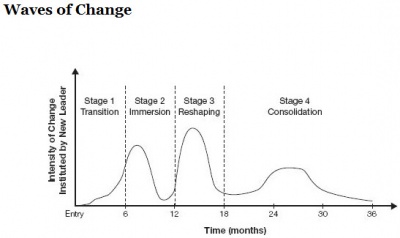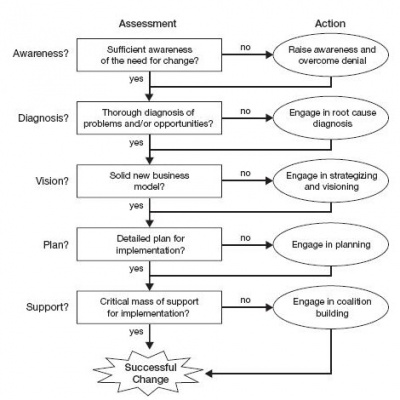90 Days - Part 4: Secure Early Wins
Contents
[hide]Summary
Establishing early wins - critical part of 90 day plan, but focus on how to secure them in the correct way. Common traps to avoid:
- Failing to focus
- Not taking business situation into account
- Not adjusting to the culture
- Failing to get wins that matter to boss(es)
- Letting means undermine the ends (Process matters)
Waves of Change

Establish correct pace that allows deeper learning, people to come along with the ride. As illustrated, Jack Gabarro refers to waves that are associated with what is typically planned and implemented during periods of change. Early waves of change are followed by a slower pace, allowing change to be absorbed, also allowing to gather deeper insight. This allows focus and fine tuning to maximize the benefits recognized through change.
Goal of the first wave is to secure early wins. Establish credibility, develop key working relationships, harvest low-hanging opportunities, high potential opportunities for short-term improvements.
Second wave is focused on strategy, structure, systems and skills within the organization.
Establishing Long-Term Goals
First 90 involves personal credibility and organizational momentum; early wins. With momentum and early wins should be development and/or adoption to long-term goals, roadmap. Foundation for major swim lanes, milestones, and what these will deliver to the organization.
A-List Priorities
Develop as part of long-term goals roadmap:
- A-List should align with core problems
- A-List; Neither to general nor too specific
- A-List should offer clear direction with flexibility (learning more through waves, adjusting)
Targeting Behavioral Changes
Behavioral changes is part of A-List goals; addressing patterns which may not align with priorities. Ensure strategy addresses behavioral priorities:
- Focus
- Discipline
- Innovation
- Teamwork
- Sense of Urgency
Credibility
Building Credibility
Recognition of the earliest actions; disproportional influence on perception. Built solid credibility:
- How to get connected through organization
- Key messages about who you are, what you represent
- Best ways to convey messages
- Identification of key audiences- direct reports, other employees, key outside contacts
- Values, style, and how you plan to conduct business
- Introductions
- Direct reports - one-on-one
- Followed by group
- Other channels
As introductions are made, focus on strained relationships, repair. Cut out redundant meetings, shorten excessively long ones, etc.
Credibility is built, perceived as more credible:
- Demanding, but able to be satisfied
- Accessible but not too familiar
- Decisive by judicious
- Focused by flexible
- Active without commotion
- Willing to make tough calls but humane
Leveraging "Teachable Moments"
- Early actions often get transformed into stories
- Take time to informally introduce yourself to support staff, etc.
- Seek "Teachable moments"
Secure Tangible Results
- Modest expenditure, yielding visible operational and financial gains
- Two or three key areas where you seek to achieve rapdid improvement
Setting stage for securing early wins, learning agenda should address how you identify promising opportunities for improvement. Translate your goals into specific initiatives:
- Align with long-term goals
- Identify promising focal points
- Concentrate on most promising focal points
- Launch pilot projects
- SFL WFM Example
- Elevate change agents
Leverage pilot projects to introduce new behaviors Key WFM challenges good prospects for, especially process and policy that impacts front line agents, building momentum from ground up.
Avoiding Predictable Surprises
Identify potential problems to minimize impact to early wins and credibility:
- External environment
- Trends in public opinion, government action, economic conditions
- Customers, Markets, Competitors and Strategy
- Internal capabilities
- Organizational politics
Leading Change

When working out where early wins will be targeted, identify the way in which this change will be implemented. There are two methods for implementing change, depending on whether five conditions are met:
- Awareness: Critical mass aware for the need for change
- Diagnosis: What and Why is clear
- Vision: Compelling vision and solid strategy exists
- Plan: Expertise, detailed plan
- Support: Sufficiently powerful coalition to support implementation
If all five of these conditions are not met, focus on establishing a collective learning process. Exposing key members to new data, customer sat, best in class methods, etc.
Change within organization results in cultural changes - awareness of addressing critical.